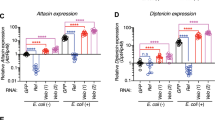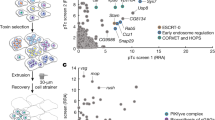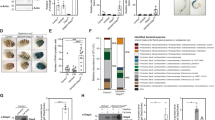Abstract
We report here the identification and functional characterization of DmMyD88, a gene encoding the Drosophila homolog of mammalian MyD88. DmMyD88 combines a Toll–IL-1R homology (TIR) domain and a death domain. Overexpression of DmMyD88 was sufficient to induce expression of the antifungal peptide Drosomycin, and induction of Drosomycin was markedly reduced in DmMyD88-mutant flies. DmMyD88 interacted with Toll through its TIR domain and required the death domain proteins Tube and Pelle to activate expression of Drs, which encodes Drosomycin. DmMyD88-mutant flies were highly susceptible to infection by fungi and Gram-positive bacteria, but resisted Gram-negative bacterial infection much as did wild-type flies. Phenotypic comparison of DmMyD88-mutant flies and MyD88-deficient mice showed essential differences in the control of Gram-negative infection in insects and mammals.
This is a preview of subscription content, access via your institution
Access options
Subscribe to this journal
Receive 12 print issues and online access
$209.00 per year
only $17.42 per issue
Buy this article
- Purchase on Springer Link
- Instant access to full article PDF
Prices may be subject to local taxes which are calculated during checkout






Similar content being viewed by others
References
Janeway, C. A. Jr Inaugural article: How the immune system works to protect the host from infection: A personal view. Proc. Natl Acad. Sci. USA 98, 7461–7468 (2001).
Schnare, M. et al. Toll-like receptors control activation of adaptive immune responses. Nature Immunol. 2, 947–950 (2001).
Hoffmann, J. A., Kafatos, F. C., Janeway, C. A. & Ezekowitz, R. A. Phylogenetic perspectives in innate immunity. Science 284, 1313–1318 (1999).
Lemaitre, B., Nicolas, E., Michaut, L., Reichhart, J. & Hoffmann, J. The dorsoventral regulatory gene cassette spätzle/Toll/cactus controls the potent antifungal response in Drosophila adults. Cell 86, 973–983 (1996).
Lemaitre, B., Reichhart, J. & Hoffmann, J. Drosophila host defense: differential induction of antimicrobial peptide genes after infection by various classes of microorganisms. Proc. Natl Acad. Sci. USA 94, 14614–14619 (1997).
Levashina, E. A. et al. Constitutive activation of toll-mediated antifungal defense in serpin-deficient Drosophila. Science 285, 1917–1919 (1999).
Nicolas, E., Reichhart, J., Hoffmann, J. & Lemaitre, B. In vivo regulation of the IκB homologue cactus during the immune response of Drosophila. J. Biol. Chem. 273, 10463–10469 (1998).
Rutschmann, S. et al. The Rel protein DIF mediates the Toll-dependent antifungal response in Drosophila. Immunity 12, 569–580 (2000).
Meng, X., Khanuja, B. S. & Ip, Y. T. Toll receptor–mediated Drosophila immune response requires Dif, an NF-κB factor. Genes Dev. 13, 792–797 (1999).
Manfruelli, P., Reichhart, J. M., Steward, R., Hoffmann, J. A. & Lemaitre, B. A mosaic analysis in Drosophila fat body cells of the control of antimicrobial peptide genes by the Rel proteins Dorsal and DIF. EMBO J. 18, 3380–3391 (1999).
Khush, R. S., Leulier, F. & Lemaitre, B. Drosophila immunity: two paths to NF-κB. Trends Immunol. 22, 260–264 (2001).
Medzhitov, R., Preston-Hurlburt, P. & Janeway, C. A human homologue of the Drosophila Toll protein signals activation of adaptive immunity. Nature 388, 394–397 (1997).
Akira, S., Takeda, K. & Kaisho, T. Toll-like receptors: critical proteins linking innate and acquired immunity. Nature Immunol. 2, 675–680 (2001).
Imler, J. & Hoffmann, J. A. Toll receptors in innate immunity. Trends Cell Biol. 11, 304–311 (2001).
Medzhitov, R. et al. MyD88 is an adaptor protein in the hToll/IL-1 receptor family signaling pathways. Mol. Cell 2, 253–258 (1998).
Muzio, M., Ni, J., Feng, P. & Dixit, V. M. IRAK (Pelle) family member IRAK-2 and MyD88 as proximal mediators of IL- 1 signaling. Science 278, 1612–1615 (1997).
Wesche, H., Henzel, W. J., Shillinglaw, W., Li, S. & Cao, Z. MyD88: an adapter that recruits IRAK to the IL-1 receptor complex. Immunity 7, 837–847 (1997).
Takeuchi, O. et al. Cellular responses to bacterial cell wall components are mediated through MyD88-dependent signaling cascades. Int. Immunol. 12, 113–117 (2000).
Galindo, R. L., Edwards, D. N., Gillespie, S. K. & Wasserman, S. A. Interaction of the pelle kinase with the membrane-associated protein tube is required for transduction of the dorsoventral signal in Drosophila embryos. Development 121, 2209–2218 (1995).
Shen, B. & Manley, J. L. Phosphorylation modulates direct interactions between the Toll receptor, Pelle kinase and Tube. Development 125, 4719–4728 (1998).
Wasserman, S. A. Toll signaling: the enigma variations. Curr. Opin. Genet. Dev. 10, 497–502 (2000).
Xu, Y. et al. Structural basis for signal transduction by the Toll/interleukin-1 receptor domains. Nature 408, 111–115 (2000).
Tauszig, S., Jouanguy, E., Hoffmann, J. A. & Imler, J. L. Toll-related receptors and the control of antimicrobial peptide expression in Drosophila. Proc. Natl Acad. Sci. USA 97, 10520–10525 (2000).
Clemens, J. C. et al. Use of double-stranded RNA interference in Drosophila cell lines to dissect signal transduction pathways. Proc. Natl Acad. Sci. USA 97, 6499–6503 (2000).
Georgel, P. et al. Drosophila immune deficiency (IMD) is a death domain protein that activates the antibacterial response and can promote apoptosis. Dev. Cell 1, 503–514 (2001).
Rutschmann, S. et al. Role of Drosophila IKKγ in a Toll-independent antibacterial immune response. Nature Immunol. 1, 342–347 (2000).
Edwards, D. N., Towb, P. & Wasserman, S. A. An activity-dependent network of interactions links the Rel protein Dorsal with its cytoplasmic regulators. Development 124, 3855–3864 (1997).
Hacker, H. et al. Immune cell activation by bacterial CpG-DNA through myeloid differentiation marker 88 and tumor necrosis factor receptor–associated factor (TRAF) 6. J. Exp. Med. 192, 595–600 (2000).
Kawai, T., Adachi, O., Ogawa, T., Takeda, K. & Akira, S. Unresponsiveness of MyD88-deficient mice to endotoxin. Immunity 11, 115–122 (1999).
Schnare, M., Holtdagger, A. C., Takeda, K., Akira, S. & Medzhitov, R. Recognition of CpG DNA is mediated by signaling pathways dependent on the adaptor protein MyD88. Curr. Biol. 10, 1139–1142 (2000).
Takeuchi, O., Hoshino, K. & Akira, S. Cutting edge: TLR2-deficient and MyD88-deficient mice are highly susceptible to Staphylococcus aureus infection. J. Immunol. 165, 5392–5396 (2000).
Michel, T., Reichhart, J. M., Hoffmann, J. A. & Royet, J. Drosophila Toll is activated by Gram-positive bacteria via a circulating peptidoglycan recognition protein. Nature 414 (in the press, 2001).
Vidal, S. et al. Mutations in the Drosophila dTAK1 gene reveal a conserved function for MAPKKKs in the control of rel/NF-κB-dependent innate immune responses. Genes Dev 15, 1900–1912 (2001).
Elrod-Erickson, M., Mishra, S. & Schneider, D. Interactions between the cellular and humoral immune responses in Drosophila. Curr. Biol. 10, 781–784 (2000).
Hedengren, M. et al. Relish, a central factor in the control of humoral but not cellular immunity in Drosophila. Mol. Cell 4, 1–20 (1999).
Leulier, F., Rodriguez, A., Khush, R. S., Abrams, J. M. & Lemaitre, B. The Drosophila caspase Dredd is required to resist Gram-negative bacterial infection. EMBO Reports 1, 353–358 (2000).
Lu, Y., Wu, L. P. & Anderson, K. V. The antibacterial arm of the Drosophila innate immune response requires an IκB kinase. Genes Dev. 15, 104–110 (2001).
Poltorak, A. et al. Defective LPS signaling in C3H/HeJ and C57BL/10ScCr mice: mutations in Tlr4 gene. Science 282, 2085–2088 (1998).
Qureshi, S. T. et al. Endotoxin-tolerant mice have mutations in Toll-like receptor 4 (Tlr4) [published erratum appears in J Exp Med 1999 May 3;189(9):following 1518]. J. Exp. Med. 189, 615–625 (1999). Published erratum: J. Exp. Med. 189, 1518 (1999).
Eldon, E. et al. The Drosophila 18 wheeler is required for morphogenesis and has striking similarities to Toll. Development 120, 885–899 (1994).
Gerttula, S., Jin, Y. S. & Anderson, K. V. Zygotic expression and activity of the Drosophila Toll gene, a gene required maternally for embryonic dorsal–ventral pattern formation. Genetics 119, 123–133 (1988).
Hashimoto, C., Hudson, K. & Anderson, K. The Toll gene of Drosophila, required for dorsal–ventral embryonic polarity, appears to encode a transmembrane protein. Cell 52, 269–279 (1988).
Chiang, C. & Beachy, P. A. Expression of a novel Toll-like gene spans the parasegment boundary and contributes to hedgehog function in the adult eye of Drosophila. Mech. Dev. 47, 225–239 (1994).
Du, X., Poltorak, A., Wei, Y. & Beutler, B. Three novel mammalian toll-like receptors: gene structure, expression, and evolution. Eur. Cytokine Netw. 11, 362–371 (2000).
Luo, C. & Zheng, L. Independent evolution of Toll and related genes in insects and mammals. Immunogenetics 51, 92–98 (2000).
Horng, T. & Medzhitov, R. Drosophila MyD88 is an adapter in the Toll signaling pathway. Proc. Natl Acad. Sci. USA 98, 12654–12658 (2001).
Krasnow, M. A., Saffman, E. E., Kornfeld, K. & Hogness, D. S. Transcriptional activation and repression by Ultrabithorax proteins in cultured Drosophila cells. Cell 57, 1031–1043 (1989).
Brand, A. H. & Perrimon, N. Targeted gene expression as a means of altering cell fates and generating dominant phenotypes. Development 118, 401–415 (1993).
Rorth, P. et al. Systematic gain-of-function genetics in Drosophila. Development 125, 1049–1057 (1998).
Xiao, T., Towb, P., Wasserman, S. A. & Sprang, S. R. Three-dimensional structure of a complex between the death domains of Pelle and Tube. Cell 99, 545–555 (1999).
Acknowledgements
We thank R. O. Clauss, E. Santiago, R. Syllas and C. Chevalier for expert technical support; D. Ferrandon and P. Ligoxigakis for critical reading of the manuscript; our colleagues for stimulating discussions and suggestions; R. Medzhitov for sharing unpublished information; and the Bloomington Stock Center for fly strains. Supported by grants from the Centre National de la Recherche Scientifique, the Ministère de l'Education Nationale de la Recherche et de la Technologie, the National Institutes of Health, EntoMed (Strasbourg, France) and Exelixis (San Francisco, CA).
Author information
Authors and Affiliations
Corresponding author
Ethics declarations
Competing interests
The authors declare no competing financial interests.
Rights and permissions
About this article
Cite this article
Tauszig-Delamasure, S., Bilak, H., Capovilla, M. et al. Drosophila MyD88 is required for the response to fungal and Gram-positive bacterial infections. Nat Immunol 3, 91–97 (2002). https://doi.org/10.1038/ni747
Received:
Accepted:
Published:
Issue Date:
DOI: https://doi.org/10.1038/ni747
This article is cited by
-
Drosophila caspases as guardians of host-microbe interactions
Cell Death & Differentiation (2023)
-
Verloren negatively regulates the expression of IMD pathway dependent antimicrobial peptides in Drosophila
Scientific Reports (2021)
-
Trk1-mediated potassium uptake contributes to cell-surface properties and virulence of Candida glabrata
Scientific Reports (2019)
-
Comparative genomic analysis of innate immunity reveals novel and conserved components in crustacean food crop species
BMC Genomics (2017)
-
Genome engineering in the yeast pathogen Candida glabrata using the CRISPR-Cas9 system
Scientific Reports (2016)



